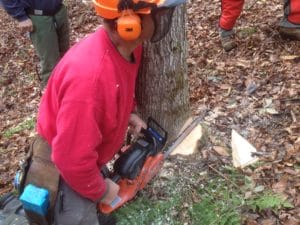Chainsaw Safety, an Absolute Necessity
Most farmers and rural landowners own chainsaws for a variety of purposes, the majority of which involve the cutting of trees and firewood. Chainsaws, in the hands of the untrained or those who do not follow common safety rules, are in danger of causing serious injury or death to themselves. This year alone, I have seen chainsaws used in reckless, hazardous manners on a number of “homesteading” oriented television shows. I cringe when I see chainsaws operated by people with no personal protective equipment at all, who are using the chainsaws recklessly. These shows are a disservice to those watching, who may then seek to emulate the heroes they see on television by adopting unsafe, dangerous practices. If you are an employer, and have employees using chainsaws for any reason, it is incumbent upon you to provide the correct safety equipment and training for your employees.
The chainsaw is one of the most efficient and productive portable power tools in use today. It can also be one of the most dangerous. If you learn to operate it properly and maintain the saw in good working order, you can avoid injury in addition to achieving higher productivity.
I speak from experience; in the early 1980’s I was cutting firewood in my farmyard when I was involved in a serious kickback injury with the bar of the chainsaw ripping through the left side of my face and left upper shoulder. After healing from this ordeal I knew enough to purchase a chainsaw that has kickback protection built into the saw.
No better source of information can be found than the U.S. Department of Labor’s OSHA (Occupational Safety and Health Administration) “Working Safely with Chainsaws” fact sheet, available here. I will paraphrase and summarize much of this information here, in the interest of brevity.
More information than can be included in this article will follow in the future on pre-operational chainsaw maintenance checks, what to do while running the chainsaw, and training requirements for employers.
Personal Protective Equipment Requirements:
- Personal protective equipment (PPE) for the head, ears, eyes, face, hands, and legs are designed to prevent or lessen the severity of injuries for workers using chainsaws.
- PPE must be inspected prior to use on each work shift to ensure it is in serviceable condition
- The following PPE MUST be used when using chainsaws:
- Head protection
- Hearing protection
- Eye face protection
- Leg protection
- Foot protection
- Hand protection
An excellent training vehicle available to loggers, farmers, homeowners, and anyone regularly using chainsaws is available from “The Game of Logging”, a program which has its roots in Sweden and which has been regularly used here in the United States. Different levels of training are available, and are often cost-shared by the NY State Center for Agriculture Medicine and Health in Cooperstown.
Read more on the Game of Logging and the New York Logger Training program at: New York Logger Training.
Chainsaw Safety, Part Two
Chainsaw Safety, Part Three
Chainsaw Safety, Part Four


